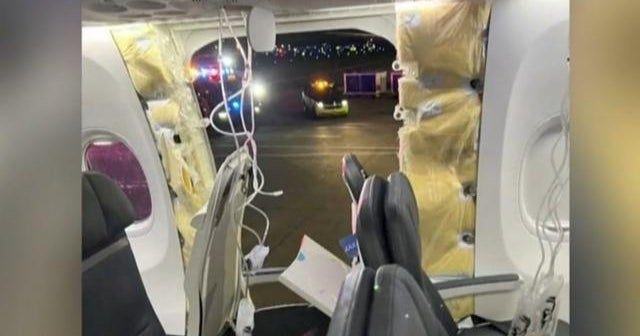The manufacturer of the door plug that was blown out in mid-air during a Alaska Airlines flight on Friday was the focus of a class-action lawsuit filed less than a month earlier, with the complaint alleging that Spirit AeroSystems had experienced “sustained quality failures” in its products.
The complaint, filed on December 19 in federal court in New York, was filed on behalf of investors in Spirit AeroSystems, which was originally a manufacturing unit of Boeing until it was spun off in 2005 (The company has no relationship with Spirit Airlines.) According to the suit, Spirit relies heavily on Boeing for orders and manufactures much of the aviation giant’s jet fuselages.
The lawsuit was earlier reported by the investigative publication The Lever,
The midair incident involved a door plug, panels designed to fit into doors that typically aren’t needed on an aircraft, transforming them into windows. One of these plugs was sucked out of a Boeing 737 Max 9 flown by Alaska Airlines just minutes after the plane departed Oregon’s Portland International Airport on its way to Ontario, California.
Alaska and United Airlines — the only two U.S. carriers to fly the Boeing 737 Max 9 — have since said they have found loose bolts inside several other door plugs on the jets, which the Federal Aviation Administration has grounded.
The lawsuit is noteworthy because of its allegations of manufacturing problems, including a complaint from one Spirit employee who alleged an “excessive amount of defects” in an email to one of the company’s executives. While none of the issues flagged in the lawsuit specifically involve door plugs, the claim alleges that Spirit’s “quality failures were so severe and persistent that Boeing even placed Spirit on probation for multiple years.”
Spirit declined to comment on the litigation. “Spirit is following the protocols set by the regulatory authorities that guide communication in these types of circumstances, and we will share further information when appropriate,” the company said a statement.
Boeing also declined to comment. “We are committed to ensuring every Boeing airplane meets design specifications and the highest safety and quality standards,” the company said Monday in a statement about the Alaska Airlines incident.
Alleged quality problems: Missing fasteners and debris
The lawsuit alleges that Spirit’s problems were “widespread,” including “the routine presence of foreign object debris (‘FOD’) in Spirit products, missing fasteners, peeling paint, and poor skin quality.”
“Such constant quality failures resulted in part from Spirit’s culture which prioritized production numbers and short-term financial outcomes over product quality,” the complaint claims.
The complaint also alleged that Spirit experienced two specific manufacturing problems. The first involves a claim that Spirit had “mis-drilled holes on the 737 Max aft pressure bulkhead,” which is at the rear of the plane. The second alleged problem involves a “defect relating to the tail fin fittings on certain 737 MAX aircraft,” an issue that was flagged by Boeing in April.
Amid its manufacturing problems and a plunging stock price, Spirit overhauled its executive suite in recent months. The company in October named Pat Shanahan as its new CEO, replacing Thomas C. Gentile III, who is a defendant in the class-action suit and who had served as CEO since 2016.

